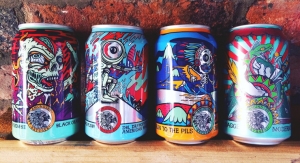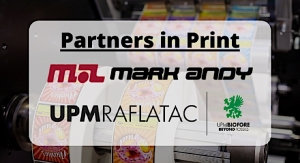02.22.16
Heidelberg is extending its digital printing portfolio for drupa 2016 with a world premiere for the industrial production of digital printing applications in B1 format. The company will introduce Heidelberg Primefire 106, based on the leading inkjet technology from its development partner Fujifilm and the performance platform from its own offset technology.
Core competencies of Heidelberg, such as the non-contacting paper sheet guide or the proven feeder and delivery technology, are therefore incorporated into the system. The company is smoothing the way for the industrial production of digital printing applications in a new format class. Heidelberg is also taking account of the demanding market requirements of many companies, particularly from the consumer goods industry. The company wants an integrated solution for fast, flexible, versioned or personalized, demand-oriented and economic production of innovative printed products in short-to-medium production runs to support its increasingly digitized production processes, with quality on par with the standard familiar from offset printing. At the same time, Heidelberg is opening up new business models for users which meet these requirements head on.
“With the world premiere of the Heidelberg Primefire 106, we have reached another milestone in our digital strategy: achieving success in working with partners to bring systems to the market within the shortest time. This will help our customers to address the increased market challenges in a digitized world in the future also. Now we are the first provider to enable the industrial and integrated production of digital printed products in the Smart Print Shop. At the same time, in doing so we are also opening up opportunities for the future growth of Heidelberg,” says Stephan Plenz, member of the management board and responsible for Heidelberg Equipment.
As of drupa 2016, Heidelberg will be repeating its approach with the Speedmaster series by presenting its entire digital printing offering under a standardized family name, the “Fire” product line. While the Speedmaster range predominantly stands for maintaining the competitiveness of a print shop’s core business, the digital printing portfolio is aimed at particularly innovative business models and pioneering printing applications. With this rename, Heidelberg is increasing both the clarity of the entire offering and the recognition value of the brand for customers.
“The name ‘Fire’ for our digital printing portfolio stands for performance, dynamism and growth – and also for digitally transmitting data and ink onto different surfaces,” says Jason Oliver, head of the Digital Division at Heidelberg. “We want to send a clear message to our customers that we have one of the highest performance digital printing offerings in our industry.”
The Heidelberg digital printing offering will therefore have the following structure as of drupa 2016:
Heidelberg Primefire 106: The new digital inkjet printing system for the industrial production of digital and innovative printing applications in B1 format meets the highest standards.
Heidelberg Versafire CP/CV is the new name for the existing Linoprint CP/CV digital printing systems. The Heidelberg Versafire is therefore the all-round system for the economic production of short and personalized runs in combination with a large choice of substrates and an impressive price/performance ratio. Heidelberg launched the system in cooperation with its partner Ricoh in 2011, and has been continuously refining it ever since.
Gallus Labelfire 340 is the new product name for the former Gallus DCS 340 for the growth market of digital label printing. The machine was successfully launched at Labelexpo 2015 in Brussels. It is distributed by Gallus, the Swiss subsidiary of Heidelberg.
Heidelberg Omnifire 250/1000 is the new name for Heidelberg’s 4D printing systems, replacing the former name Heidelberg Jetmaster Dimension 250/1000. Heidelberg uses the term 4D printing to describe the personalized and flexible printing on various three-dimensional objects such as balls, drinking bottles, and other mass-produced items, especially from the consumer goods industry. In addition, Heidelberg is working on the development of systems also suitable for industrial applications, for example in the automotive industry. The launch of the Heidelberg Omnifire 1000 is planned for the end of 2016.
A comprehensive range of services and consumables is also available for all products to enable users to exploit the potential of their value chain as fully as possible.
Core competencies of Heidelberg, such as the non-contacting paper sheet guide or the proven feeder and delivery technology, are therefore incorporated into the system. The company is smoothing the way for the industrial production of digital printing applications in a new format class. Heidelberg is also taking account of the demanding market requirements of many companies, particularly from the consumer goods industry. The company wants an integrated solution for fast, flexible, versioned or personalized, demand-oriented and economic production of innovative printed products in short-to-medium production runs to support its increasingly digitized production processes, with quality on par with the standard familiar from offset printing. At the same time, Heidelberg is opening up new business models for users which meet these requirements head on.
“With the world premiere of the Heidelberg Primefire 106, we have reached another milestone in our digital strategy: achieving success in working with partners to bring systems to the market within the shortest time. This will help our customers to address the increased market challenges in a digitized world in the future also. Now we are the first provider to enable the industrial and integrated production of digital printed products in the Smart Print Shop. At the same time, in doing so we are also opening up opportunities for the future growth of Heidelberg,” says Stephan Plenz, member of the management board and responsible for Heidelberg Equipment.
As of drupa 2016, Heidelberg will be repeating its approach with the Speedmaster series by presenting its entire digital printing offering under a standardized family name, the “Fire” product line. While the Speedmaster range predominantly stands for maintaining the competitiveness of a print shop’s core business, the digital printing portfolio is aimed at particularly innovative business models and pioneering printing applications. With this rename, Heidelberg is increasing both the clarity of the entire offering and the recognition value of the brand for customers.
“The name ‘Fire’ for our digital printing portfolio stands for performance, dynamism and growth – and also for digitally transmitting data and ink onto different surfaces,” says Jason Oliver, head of the Digital Division at Heidelberg. “We want to send a clear message to our customers that we have one of the highest performance digital printing offerings in our industry.”
The Heidelberg digital printing offering will therefore have the following structure as of drupa 2016:
Heidelberg Primefire 106: The new digital inkjet printing system for the industrial production of digital and innovative printing applications in B1 format meets the highest standards.
Heidelberg Versafire CP/CV is the new name for the existing Linoprint CP/CV digital printing systems. The Heidelberg Versafire is therefore the all-round system for the economic production of short and personalized runs in combination with a large choice of substrates and an impressive price/performance ratio. Heidelberg launched the system in cooperation with its partner Ricoh in 2011, and has been continuously refining it ever since.
Gallus Labelfire 340 is the new product name for the former Gallus DCS 340 for the growth market of digital label printing. The machine was successfully launched at Labelexpo 2015 in Brussels. It is distributed by Gallus, the Swiss subsidiary of Heidelberg.
Heidelberg Omnifire 250/1000 is the new name for Heidelberg’s 4D printing systems, replacing the former name Heidelberg Jetmaster Dimension 250/1000. Heidelberg uses the term 4D printing to describe the personalized and flexible printing on various three-dimensional objects such as balls, drinking bottles, and other mass-produced items, especially from the consumer goods industry. In addition, Heidelberg is working on the development of systems also suitable for industrial applications, for example in the automotive industry. The launch of the Heidelberg Omnifire 1000 is planned for the end of 2016.
A comprehensive range of services and consumables is also available for all products to enable users to exploit the potential of their value chain as fully as possible.



























